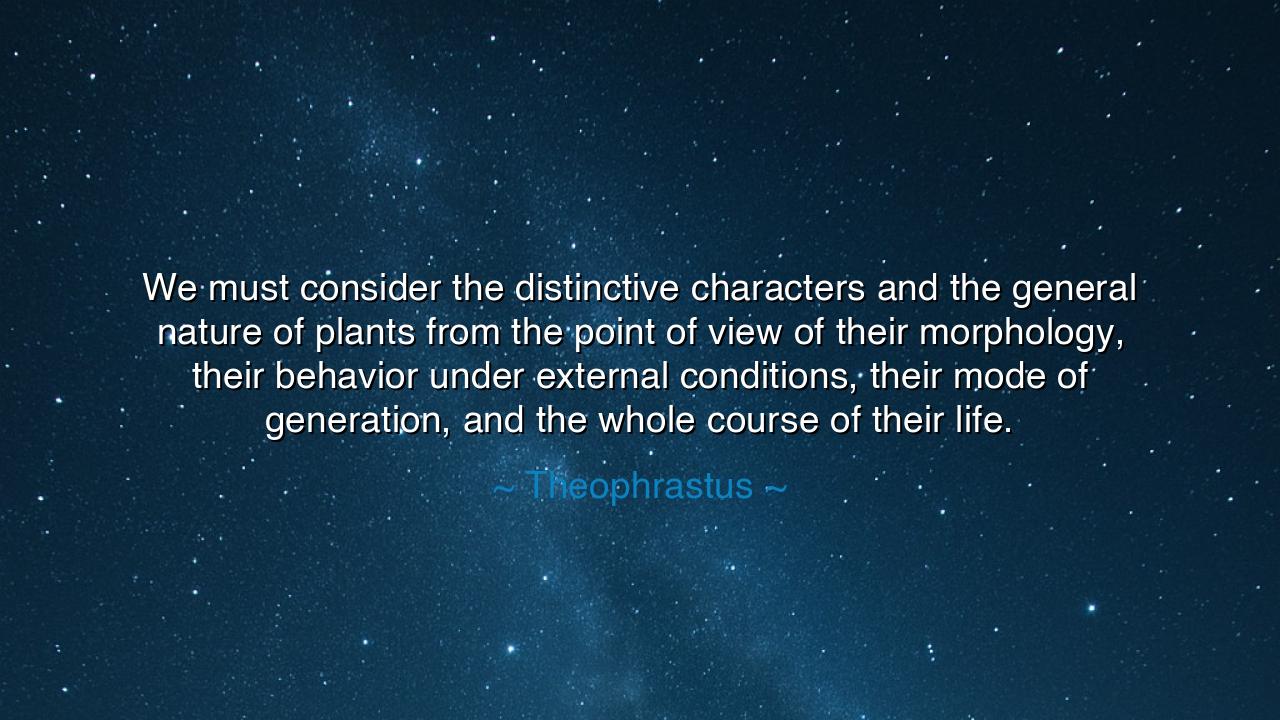
We must consider the distinctive characters and the general
We must consider the distinctive characters and the general nature of plants from the point of view of their morphology, their behavior under external conditions, their mode of generation, and the whole course of their life.






Theophrastus, the disciple of Aristotle and often called the “Father of Botany,” once declared with clarity of vision: “We must consider the distinctive characters and the general nature of plants from the point of view of their morphology, their behavior under external conditions, their mode of generation, and the whole course of their life.” These words are not mere instruction for scholars of the earth, but a call to see creation with eyes of reverence, to study not in fragments but in wholeness, and to seek understanding not only of the parts but of the living harmony that binds them together.
The meaning of this quote lies in its insistence on balance and completeness. Theophrastus urges us to look at plants not in isolation, but in their fullness—how they grow, how they respond to external conditions, how they reproduce, and how their lives unfold from beginning to end. He teaches us that to know something truly is to know it in its entirety, to grasp its nature as a whole, rather than to pluck out only convenient details. This wisdom stretches far beyond botany, echoing into all study and all of life: true knowledge is never partial, but seeks to honor the complete pattern.
The origin of this teaching rests in the great flowering of Greek philosophy, when men like Aristotle and his student Theophrastus sought to bring order to knowledge. Where others saw the wild chaos of plants and animals, Theophrastus sought their characters, their distinctions, their likenesses, and their purposes. His words mark the birth of systematic science, where careful observation replaced myth, and patient classification became the path to wisdom. Yet though his method was rigorous, it was not dry; for him, to study a leaf or a root was to touch the very rhythm of life itself.
History offers us stories that illustrate this truth. Consider the voyages of Charles Darwin, who centuries later, on the decks of the Beagle, studied not only the shapes of plants but their relations to climate, soil, and the creatures around them. From this holistic vision arose the theory of evolution, a framework that reshaped human understanding of life. Or think of Mendel, the monk in his garden, who studied the mode of generation of peas, seeing patterns in their inheritance. Both Darwin and Mendel followed in the path Theophrastus marked: to look at the whole course of life with patient eyes, and thus uncover the secrets hidden in simplicity.
Theophrastus’ words also remind us of humility. For to see the behavior of plants under external conditions is to recognize that they, like us, live in response to their environment. The bending of a tree toward the sun, the blossoming of flowers in spring, the withering of leaves in drought—all teach us that life is not self-contained but bound to the world around it. In this we glimpse our own reflection, for humans too are shaped by conditions, by seasons of fortune and hardship. To study the nature of plants is thus to study the laws of life itself.
The lesson we may draw is this: seek knowledge in wholeness, and let every study be also a meditation on the unity of life. Do not be content with fragments, for the truth lies in patterns, in connections, in the great weaving of existence. Approach even the smallest seed with wonder, for in its growth is written the same wisdom that governs the stars. Theophrastus’ teaching is not for botanists alone, but for all who wish to live wisely: know the character, know the nature, know the conditions, know the cycle, and in knowing, you honor the life before you.
Practically, this means observing with patience, listening to what the world teaches in its silence. If you walk among plants, see not only their shape but their story—how they adapt, how they endure, how they flourish. If you study people, seek to understand not only their actions but the conditions that shape them, the roots from which they come, and the full arc of their journey. In all things, practice holistic vision, for partial knowledge breeds arrogance, but complete understanding fosters wisdom.
So let Theophrastus’ words endure: to know the nature of plants is to know the rhythm of life itself, and to see in their growth, their struggle, and their flourishing the eternal truth that life is a harmony of character, condition, generation, and destiny. To walk in such wisdom is to live not as a fragment, but as one who understands the great whole.






AAdministratorAdministrator
Welcome, honored guests. Please leave a comment, we will respond soon